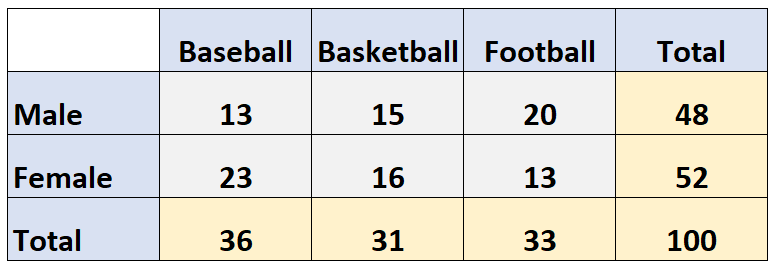如何在 r 中打印数组(3 个示例)
通常,您可能希望在 R 中将表格打印到控制台来总结数据集的值。
以下示例演示如何使用table()和as.table()函数在 R 中打印表格。
示例 1:根据数据打印单向表
假设我们在 R 中有以下数据框:
#create data frame df <- data. frame (team=c('A', 'A', 'A', 'B', 'B', 'B', 'C', 'C', 'C'), position=c('Guard', 'Guard', 'Forward', 'Guard', 'Forward', 'Forward', 'Guard', 'Guard', 'Forward'), points=c(14, 12, 15, 20, 22, 36, 10, 16, 19)) #view data frame df team position points 1 A Guard 14 2 A Guard 12 3 A Forward 15 4 B Guard 20 5B Forward 22 6 B Forward 36 7 C Guard 10 8 C Guard 16 9 C Forward 19
我们可以使用table()函数来汇总位置列中每个唯一值的计数:
#create table for 'position' variable
table1 <- table(df$position)
#view table
table1
Forward Guard
4 5
从表中我们可以看到,“前锋”在位置栏中出现了 4 次,“后卫”出现了 5 次。
这称为单向表,因为它汇总了一个变量。
示例 2:根据数据打印双向数组
让我们再次假设 R 中有以下数据框:
#create data frame df <- data. frame (team=c('A', 'A', 'A', 'B', 'B', 'B', 'C', 'C', 'C'), position=c('Guard', 'Guard', 'Forward', 'Guard', 'Forward', 'Forward', 'Guard', 'Guard', 'Forward'), points=c(14, 12, 15, 20, 22, 36, 10, 16, 19)) #view data frame df team position points 1 A Guard 14 2 A Guard 12 3 A Forward 15 4 B Guard 20 5B Forward 22 6 B Forward 36 7 C Guard 10 8 C Guard 16 9 C Forward 19
我们可以使用table()函数来汇总团队和位置列中每个唯一值的计数:
#create two-way table for 'team' and 'position' variables table2 <- table(df$team, df$position) #view table table2 Forward Guard AT 12 B 2 1 C 1 2
从表中我们可以看出:
- A 队有1 名攻击者。
- A队有2名后卫。
- B队有2名进攻队员。
等等。
这被称为双向表,因为它总结了两个变量的数量。
示例 3:从头开始打印表格
假设我们已经知道要填充数组的值。
例如,假设我们要在 R 中创建下表,显示一项调查结果,该调查询问了 100 个人他们喜欢哪种运动:

我们可以使用R中的as.table()函数来快速创建这个表:
#create matrix data <- matrix(c(13, 23, 15, 16, 20, 13), ncol= 3 ) #specify row and column names of matrix rownames(data) <- c('Male', 'Female') colnames(data) <- c('Baseball', 'Basketball', 'Football') #convert matrix to table data <- as. table (data) #displaytable data Baseball Basketball Football Male 13 15 20 Female 23 16 13
数组中的值与我们之前看到的数组中的值相对应。
其他资源
以下教程解释了如何在 R 中执行其他常见任务: